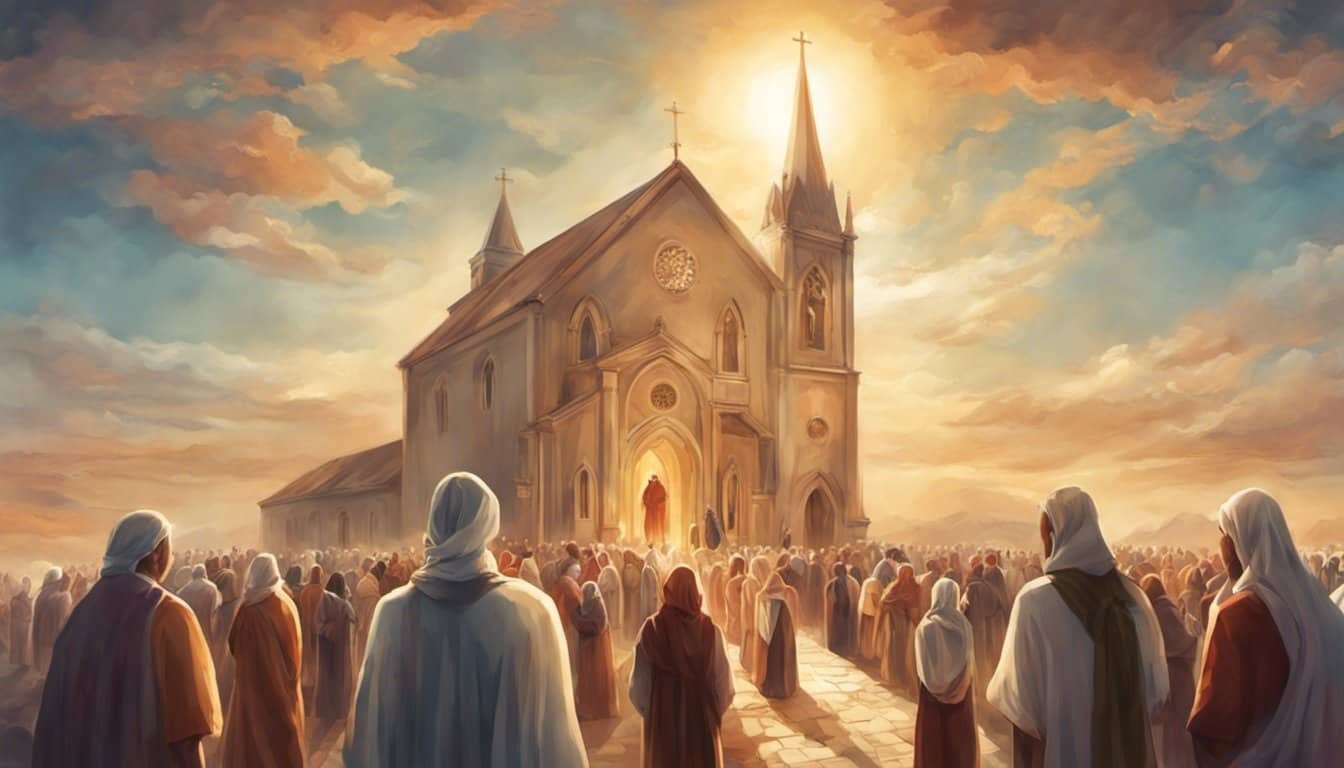Throughout history, many cultures and religions have grappled with the concept of an impending end-of-times event. While this notion may conjure up images of doomsday scenarios, the idea of a prophesied millennium or utopian age has also inspired countless movements, both religious and secular. But what is millenarianism, exactly? In this article, we will delve into the origins, beliefs, and impact of millenarianism across various religions and cultural movements. Read on to expand your understanding of this fascinating and complex concept.
Defining Millenarianism: An Overview of its Meaning, Beliefs, and History

Millenarianism is a complex and multifaceted phenomenon that has intrigued scholars and laypeople alike for centuries. At its core, millenarianism is a belief system that centers around the idea of an impending transformation of society, either for better or worse. This transformation is often seen as being tied to the end of the world in some way, and is typically associated with the arrival of a messiah or other powerful figure who will usher in a new age.
To understand millenarianism, it is important to first define the term itself. Millenarianism is derived from the Latin word “millennium,” which means “thousand years.” The term originally referred to the belief, found in the biblical book of Revelation, that there would be a thousand-year period of peace and prosperity on earth following the return of Jesus Christ. However, in a broader sense, millenarianism can refer to any belief system that incorporates the idea of a coming transformation of society.

Historically, millenarianism has been a prominent feature of many religions, including Christianity, Judaism, and Islam. In these traditions, the idea of a coming messiah or savior who will usher in a new age of peace and prosperity has been a powerful source of hope and inspiration for believers. However, millenarianism has also been associated with a number of cults and other fringe groups that subscribe to more extreme or apocalyptic beliefs.
At its core, millenarianism is rooted in the belief that the world is in need of radical transformation. Whether this transformation is seen as being brought about by divine intervention or through human action, the idea is that the world as it currently exists is deeply flawed and in need of change. This belief can be seen as both a source of hope and a source of despair, depending on the context and the specific beliefs of the group in question.
Some key beliefs and themes that are often associated with millenarianism include:
- Apocalypticism and end times: Many millenarian belief systems incorporate the idea of an impending apocalypse or end of the world. This may be seen as a necessary precursor to the coming of a messiah or other powerful figure who will bring about a new age.
- Prophecy and prophetic movements: Millenarianism often involves the belief in prophetic figures who are able to see into the future and predict key events that will lead up to the coming transformation of society.
- The messiah and the second coming: In many millenarian belief systems, the arrival of a messianic figure or the second coming of Jesus Christ is seen as a key event that will bring about the transformative change that is needed.
- Utopianism and dystopianism: Depending on the specific beliefs of the group in question, millenarianism can be seen as a utopian or dystopian vision of the future. Some millenarian groups believe in a coming age of peace, while others see a dark and chaotic future ahead.
- Social and political movements: Millenarianism can also function as a social or political movement, with believers working actively to bring about the transformative change they believe is necessary. Examples of this include various utopian communities throughout history, as well as more recent political movements that incorporate millenarian beliefs.
- Symbolism and mythology: Millenarianism often draws heavily on symbolic and mythological narratives to explain its beliefs and provide a framework for understanding the world. These narratives may be drawn from religious texts, or may be developed within the specific context of the group in question.
Overall, millenarianism is a complex and multifaceted phenomenon that has had a profound impact on human history and culture. Whether viewed as a source of hope or despair, millenarianism offers a powerful vision of the future and a compelling call to action for those who believe in its transformative potential.
Millenarianism Across Religions: Christianity, Judaism, Islam, and New Age Movements
Millenarianism is a phenomenon that can be observed across various religious and cultural contexts. While it is often associated with Christian belief systems, it is important to note that other religions also have their own interpretations of the end times and the coming of a messiah figure.
Christianity, as one of the most widely practiced religions worldwide, has a rich history of millenarian thought. The Book of Revelation in the New Testament, for instance, provides a detailed account of the apocalypse, describing events such as the Four Horsemen, the Great Tribulation, and the Second Coming of Christ. In addition to this canonical text, there have been countless prophetic movements throughout Christian history that have claimed to know when the end of the world is coming. Some of the most well-known examples of these movements include the Millerites in the 19th century and the Branch Davidians in the 20th century.
In Judaism, there is a belief in a messiah figure who will usher in a time of peace and prosperity for the world. The concept of the messiah is deeply rooted in Jewish scripture and has been the subject of much debate and discussion throughout Jewish history. While some Jews believe that the messiah has already come in the form of Jesus Christ, others are still awaiting the arrival of this savior figure.
Islam, like Christianity and Judaism, also has a strong tradition of millenarianism. In Islam, the end times are marked by the appearance of the Mahdi, who is believed to be a descendant of the Prophet Muhammad. The Mahdi is thought to bring about a period of justice and peace on earth before the final judgment.
In the New Age movement, which is a more recent phenomenon that emerged in the 1970s, there is a belief in a coming Age of Aquarius. This age is envisioned as a time of great spiritual awakening and transformation, and is often associated with ideas of planetary alignment, consciousness shift, and environmental sustainability.

While millenarianism may take different forms in different religious and cultural contexts, it is clear that the idea of a messiah figure who will bring about a better world is a powerful and enduring one. Whether it is through the Book of Revelation in Christianity, the concept of the messiah in Judaism, or the appearance of the Mahdi in Islam, millenarianism has played a significant role in shaping the beliefs and practices of these faiths.
Apocalypticism and End Times in Millenarianism: Understanding the Role of Prophecy and Prophetic Movements
Apocalypticism and end times are central beliefs in millenarianism. It is commonly believed that the world will end with a grand and catastrophic event, such as a battle between good and evil forces. This belief is often linked to the idea of a messiah or savior who will deliver believers from evil and usher them into a new, eternal era of peace and prosperity.
Here are some important points to further understand the role of prophecy and prophetic movements in millenarianism:
-
Prophecy plays a significant role in millenarianism. Prophets are individuals believed to have direct communication with a supernatural power and receive divine messages about the end times. These messages can range from warnings about impending doom to revelations about the coming of a messiah or savior.
-
Prophetic movements are also important in millenarianism. They are groups of people who come together to await the end of the world and the coming of a new era. These movements often have charismatic leaders who claim to have received messages from a higher power. They also embrace the idea of a chosen people, who are destined to survive the impending apocalypse and enter the new era.
-
Contemporary millenarian movements often reinterpret the end times in relation to modern-day events. For example, some groups may believe that global climate change or political turmoil is a sign of the end times. Others may focus on the rise of technology or the advent of artificial intelligence as the signs of a new era.
-
Millenarian beliefs can influence behavior and motivate social and political action. For example, some groups may withdraw from society to prepare for the end times, while others may actively work to create conditions they believe will hasten the arrival of the messiah or the new era.
Understanding the role of prophecy and prophetic movements in millenarianism is an important part of comprehending the beliefs and practices of these groups. Prophets and prophecy have been central to many religious traditions throughout history, and their influence on millenarianism is profound. By understanding the role of prophecy and prophetic movements, we gain a deeper understanding of the beliefs and behaviors of millenarian groups throughout history.
The Messiah, the Second Coming, and Other Eschatological Beliefs in Millenarianism
In millenarianism, the end of the world is often associated with the coming of a messiah; an individual who will bring about a utopian society or a golden age. This belief is prevalent in many religions including Christianity, Judaism, and Islam.
In Christianity, the second coming of Christ is believed to be the event that will mark the end of the world. Christians believe that Jesus will return to earth, raise the dead, judge the living and the dead, and establish a kingdom of God on earth. This belief is primarily based on the Bible’s Book of Revelation, which describes the events that will lead up to the end of the world.
« Beyond the Theology: Understanding the Concept of Sin from a Secular Perspective
Living a Purposeful Life for God: A Guide to Spiritual Growth and Devotion »
Judaism also has eschatological beliefs that involve the coming of a messiah. The Jewish messiah is believed to be a great leader or king who will rebuild the Temple in Jerusalem, gather all the Jews to Israel, and usher in an era of peace and prosperity.
In Islam, the messiah, or the Mahdi, is believed to be a descendant of the Prophet Muhammad who will come before the end of the world to restore justice and order. Muslims also believe in the return of Jesus, who will fight the Antichrist and establish a just society.
Apart from these religious beliefs, millenarianism has also been associated with many new age and cult movements. Some of these groups believe in the coming of an extraterrestrial messiah, a savior from another planet who will bring about peace and enlightenment on earth.
Eschatological beliefs are often accompanied by prophecies and prophetic movements. These movements interpret current events and predict the end of the world based on religious or spiritual texts. In many cases, the events predicted by these movements fail to occur, and their followers are left disillusioned.

The messiah and other eschatological beliefs are powerful symbols of hope for millenarians. They provide a sense of meaning and purpose, especially in times of crisis or despair. However, they can also lead to fanatical and dangerous behavior, as seen in some religious and political movements.
In conclusion, millenarianism has a rich history of eschatological beliefs that involve the coming of a messiah and the end of the world. While these beliefs can provide hope and inspiration to many, they can also be misinterpreted and lead to fanaticism. Understanding the role of the messiah and other eschatological beliefs is crucial in understanding millenarianism and its impact on society.
From Religion to Politics: Millenarianism as a Social and Cultural Movement
Millenarianism is not only a religious phenomenon, it has also impacted social and political movements throughout history. Here are some examples of how millenarian beliefs have influenced society:
-
Political Millenarianism
Political millenarianism refers to the belief that a political revolution will bring about a utopian society. This was evident in the French Revolution, which inspired many millenarian movements throughout Europe. Socialists, anarchists, and communists all had millenarian elements in their political visions. -
Social Millenarianism
Social millenarianism is the belief that a new social order will emerge that is more just and fair. The social gospel movement in Christianity and the civil rights movement in the US are examples of social millenarianism that sought to bring about racial equality and justice. -
Environmental Millenarianism
Environmental millenarianism is the belief that the world is approaching an apocalyptic end due to environmental degradation. This movement seeks to bring about a new paradigm that is more sustainable and in harmony with nature. -
Technological Millenarianism
Technological millenarianism is the belief that technology will transform society and bring about a new utopian age. Transhumanism is an example of this movement, which seeks to merge humans with machines to create a new species.
In each of these examples, millenarianism provided a vision of a better future that inspired people to take action. While some of these movements may have failed in achieving their goals, they have nevertheless left a lasting impact on society.
Millenarianism has also impacted politics in more negative ways. Some politicians have used millenarian rhetoric to incite fear and division, particularly around issues of race and religion. This can lead to the rise of extremist groups that are willing to use violence in pursuit of their goals.

In conclusion, millenarianism is not limited to religous beliefs, it can also impact social and political movements. These movements can bring about positive change, but they can also be exploited by extremists to achieve their goals. It is important to be aware of the millenarian elements in any movement and to evaluate them critically.
Sociological and Psychological Perspectives on Millenarianism: Symbolism, Mythology, and Worldview
Millenarianism is a complex belief system that has had a significant impact on societies across the world. In addition to its religious and theological roots, millenarianism has also been examined from various sociological and psychological perspectives. This section will explore the symbolism, mythology, and worldview associated with millenarianism.
Symbolism plays a crucial role in millenarianism, with many movements utilizing complex and often obscure signs and symbols to convey their beliefs and ideas. For example, Christian millenarian movements may use specific numbers (such as 666 or 144,000) or symbols (such as the four horsemen of the apocalypse) to represent various concepts related to the end times. Similarly, new age movements may draw from a wide range of spiritual and mystical traditions to create a unique set of symbols and signs that are specific to their beliefs.
Mythology also plays a vital role in millenarianism, with many movements drawing on ancient legends and stories to construct their narrative. These myths often serve as a foundation for millenarian beliefs, providing a framework for understanding the past, present, and future. Additionally, myths can be used to support certain themes or ideas such as the idea of a chosen people or the importance of sacrifice.
Finally, the worldview of millenarian movements can be examined from a sociological or psychological perspective. From a sociological perspective, millenarian movements often arise during times of social upheaval, when traditional institutions and beliefs are being challenged, and people are searching for new ways of understanding the world around them. These movements may also be driven by feelings of marginalization or oppression, with followers seeking to create a new society that better reflects their values and beliefs.

From a psychological perspective, millenarianism can be seen as a response to feelings of anxiety, uncertainty, and fear. It is not uncommon for millenarian movements to promise a utopian future, free from the troubles and challenges of the present. Similarly, millenarian movements may offer a sense of hope and purpose to those who are struggling to find meaning in their lives.
In conclusion, studying the symbolism, mythology, and worldview of millenarianism can provide valuable insights into this complex belief system. By examining the ways in which millenarian movements construct their narratives and convey their ideas, we can gain a deeper understanding of the impact that millenarianism has had on societies across the world.
Utopianism and Dystopianism in Millenarianism: Examining Concepts of Hope and Despair
When people think of millenarianism, they often associate it with apocalyptic doom and gloom. While there are certainly beliefs within millenarianism that relate to an impending catastrophic event or the end of the world, there is often also an element of hope. This hope is often seen in the form of utopianism or a belief in a better world to come. However, there can also be a darker side to millenarianism, in which the hope for a better future is accompanied by the fear of a dystopian world.
Here are some key concepts related to utopianism and dystopianism within millenarianism:
-
Utopianism: The belief in a perfect, ideal world that will one day be realized. This ideal world is often described as a place of peace, justice, and abundance, where all people are equal, and there is no war, poverty, or suffering.
-
Dystopianism: The opposite of utopianism, dystopianism is the belief in a worst-case scenario future, in which the world is plunged into chaos, violence, and suffering on an unprecedented scale. This could be the result of a natural disaster, war, or some other catastrophic event.
-
Hope: Both utopianism and dystopianism are rooted in a desire for something better. Utopianism offers hope for a brighter future, while dystopianism offers the hope of survival and the possibility of overcoming adversity.
-
Fear: Alongside hope, there is often fear associated with these concepts. For utopianism, there is the fear of what will happen if the ideal world is not realized. For dystopianism, there is the fear of what will happen if the worst-case scenario actually occurs.
-
Symbolism: The imagery of utopia and dystopia is often rich with symbolism, drawing on myths and mythic narratives to create a vision of a possible future. These symbols can include the Garden of Eden, the Tower of Babel, or the Four Horsemen of the Apocalypse.
-
Mythology: Utopian and dystopian visions are often rooted in mythological narratives, drawing on stories of gods and heroes to provide a framework for understanding the world. These mythologies can be sourced from various religions, including Christianity, Judaism, Islam, and the new age movements.
Overall, the concept of utopianism and dystopianism within millenarianism highlights the profound human desire for hope and the fear that comes with it. While these visions of the future can be powerful motivators for change, they can also be a potential source of conflict and division, particularly when they are tied to religious or political movements. For those interested in the study of millenarianism, an understanding of these concepts is essential to fully grasp the breadth of beliefs and ideologies associated with this complex phenomenon.

















